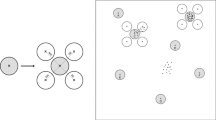Abstract
We extend the well-known double sampling for stratification sampling scheme by cluster subsampling to a three-level design and present corresponding estimators based on the infinite population approach in the first phase. After stratification of the sample points (phase I), a second-phase sample is drawn independently among the first-phase points within each stratum. On level III, clusters are formed of those phase II points and a sample of clusters is finally drawn without replacement. We used the forest planning units compartment and subdistrict as clusters and moreover formed clusters with a heuristic for the vehicle routing problem. The precision of the new estimator was compared to that achieved with classical double sampling for stratification in a case study. The results indicate that the expected increase in sampling errors caused by clustering cannot be compensated by the reduced inventory costs under the conditions given in the case study.





Similar content being viewed by others
References
Bergel D (1973) Formzahluntersuchungen an Buche, Fichte, europäischer Lärche und japanischer Lärche zur Aufstellung neuer Massentafeln. Allgemeine Forst- und Jagdzeitung 144:117–124
Bergel D (1974) Massentafeln für Nordwestdeutschland II: Eiche, Roteiche, Kiefer. Niedersächsische Forstliche Versuchsanstalt Göttingen
Böckmann T, Saborowski J, Dahm S, Nagel J, Spellmann H (1998) Die Weiterentwicklung der Betriebsinventur in Niedersachsen. Forst und Holz 53(8):219–226
Brassel P, Köhl M (2001) Visions. In: Brassel P, Lischke H (eds) Swiss national forest inventory: methods and models on the second assessment, pp 321–326
Cochran WG (1977) Sampling techniques, 3rd edn. Wiley, New York
Dantzig G, Ramser J (1959) The truck dispatching problem. Manage Sci 6:80–91
de Vries PG (1986) Sampling theory for forest inventory. Springer, Berlin
Fattorini L, Franceschi S, Pisani C (2009) A two-phase sampling strategy for large-scale forest carbon budgets. J Stat Plan Inference 139:1045–1055. doi:10.1016/j.jspi.2008.06.014
Gregoire TG, Valentine H (2008) Sampling strategies for natural ressources and the environment. Chapman & Hall/CRC, Boca Raton
Gröer C, Golden B, Wasil E (2010) A library of local search heuristics for the vehicle routing problem. Math Program Comput 2:79–101. doi:10.1007/s12532-010-0013-5
Hahsler M, Hornik K (2007) TSP-infrastructure for the traveling salesperson problem. J Stat Softw 23(2):1–21
Kleinn C (1994) Comparison of the performance of line sampling to other forms of cluster sampling. For Ecol Manage 68:365–373
Kleinn C (1996) Ein Vergleich der Effizienz von verschiedenen Clusterformen in forstlichen Großrauminventuren. Forstwissenschaftliches Centralblatt 115:378–390
Köhl M (1994) Statistisches Design für das zweite Schweizerische Landesforstinventar: Ein Folgeinventurkonzept unter Verwendung von Luftbildern und terrestrischen Aufnahmen. Mitteilungen der Eidgenössischen Forschungsanstalt für Wald. Schnee und Landschaft 69:3–141
Li F, Golden B, Wasil E (2005) Very large-scale vehicle routing: new test problems, algorithms, and results. Comput Operations Res 32:1165–1179. doi:10.1016/j.cor.2003.10.002
Lund H (1998) IUFRO Guidelines for designing multipurpose resource inventories: a project of IUFRO research group 4.02.02, IUFRO world series, vol 8. IUFRO Secretariat Vienna
Mandallaz D (2008) Sampling techniques for forest inventories. Chapman & Hall/CRC, Boca Raton
R Core Team (2012) R: a language and environment for statistical computing. R foundation for statistical computing, Vienna, Austria. http://www.R-project.org/. ISBN 3-900051-07-0
Saborowski J, Marx A, Nagel J, Böckmann T (2010) Double sampling for stratification in periodic inventories—Infinite population approach. For Ecol Manage 260:1886–1895. doi:10.1016/j.foreco.2010.08.035
Särndal CE, Swensson B, Wretman J (2003) Model assisted survey sampling. Springer, Berlin
Schreuder HT, Gregoire TG, Wood GB (1993) Sampling methods for multiressource forest inventories. Wiley, New York
Scott CT (1993) Optimal design of a plot cluster for monitoring. In: Rennolls K, Gertner G (eds) The optimal design of forest experiments and forest surveys: Proceedings, IUFRO S.4.11 conference. University of Greenwich, London, UK, pp 233–242
Scott CT, Köhl M (1994) Sampling with partial replacement and stratification. For Sci 40(1):30–46
Sloboda B, Gaffrey D, Matsumura N (1993) Regionale und lokale Systeme von Höhenkurven für gleichaltrige Waldbestände. Allgemeine Forst- und Jagdzeitung 164:225–228
Tomppo EO, Gschwantner T, Lawrence M, McRoberts RE (eds) (2010) National forest inventories. Pathways for common reporting. Springer, Heidelberg
Zinggeler J (2001) Expenditure of the terrestrial inventory. In: Brassel P, Lischke H (eds) Swiss national forest inventory: Methods and models on the second assessment, pp 88–92
Zinggeler J, Herold A (1997) Zeitlicher und finanzieller Aufwand für die terrestrische Probenahme im zweiten Schweizerischen Landesforstinventar (LFI). Schweiz Z Forstwes 148:939–959
Acknowledgments
We thank the German Science Foundation (DFG) for financial support of this study (Sachbeihilfe SA 415/5-1) and Dr. Böckmann of the Lower Saxony Forest Planning Office for his kind provision of the inventory data. Moreover, we thank anonymous reviewers for their helpful comments.
Author information
Authors and Affiliations
Corresponding author
Additional information
Communicated by A. Weiskittel.
Appendices
Appendix
Proofs
To derive the variance of the new estimator, we decompose \(\hat{\bar{y}}_h\) as follows
The variance of \(\hat{\bar{y}}_h\) is then given as the sum of the variances of the two components, because both components are not correlated (see (12.6) in Cochran 1977).
In this equation, the first variance is the variance from 2st (Eq. 2). Due to the fact that \(E_3(\hat{\bar{y}}_h-\bar{y}_h)=0, \)
holds for the second variance. Assuming simple random sampling with drawing without replacement for the clusters, the variance and the covariance can be calculated as
and
respectively. Substituting (24) and (25) in (23) yields
Rights and permissions
About this article
Cite this article
von Lüpke, N., Saborowski, J. Combining double sampling for stratification and cluster sampling to a three-level sampling design for continuous forest inventories. Eur J Forest Res 133, 89–100 (2014). https://doi.org/10.1007/s10342-013-0743-9
Received:
Revised:
Accepted:
Published:
Issue Date:
DOI: https://doi.org/10.1007/s10342-013-0743-9




